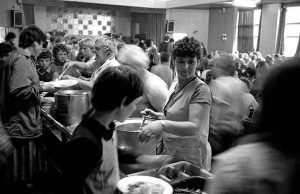 Market Anarchism is the idea we can replace capitalism with a reformed “free market”, to better meet human needs. [1] It mostly died out at the end of the 19th century, replaced by Anarchist Communism. [2] Market Anarchism is now gaining momentum again, but the arguments against it are often stuck in the 19th century, tailored toward the market anarchism of that time (it gets called mutualism, individualist anarchism, the collectivist wages system, etc). There’s plenty of general and historical critiques of the idea. [3] [4] [5] Instead of covering old ground, this article will show seven specific issues that free markets can’t deal with on their own. It will show that even in its modern form, market anarchism is not good enough to give us a humane society and has no answer to many problems working class people face.
Market Anarchism is the idea we can replace capitalism with a reformed “free market”, to better meet human needs. [1] It mostly died out at the end of the 19th century, replaced by Anarchist Communism. [2] Market Anarchism is now gaining momentum again, but the arguments against it are often stuck in the 19th century, tailored toward the market anarchism of that time (it gets called mutualism, individualist anarchism, the collectivist wages system, etc). There’s plenty of general and historical critiques of the idea. [3] [4] [5] Instead of covering old ground, this article will show seven specific issues that free markets can’t deal with on their own. It will show that even in its modern form, market anarchism is not good enough to give us a humane society and has no answer to many problems working class people face.
1. Supply and Demand
All markets measure value in numbers (prices) – that means everything can be compared against everything else. Whether it’s labour notes, [6] bitcoin [7] or old school currency, everything has a price. This has become so normal to us, that we don’t notice how absurd it is! Our desires and aspirations can’t be reduced to a number. Nor can they be precisely measured against each other. How many flat screen TVs, are worth one hospital ventilator, one intensive care unit? How many skateboards for my daily bread? It makes no sense to compare the needs of life like that. Yet to the market, they’re all just the same kind of thing: commodities. [8]
Currency is limited, it can only measure one thing at a time. All you can do with it is add more or take less. Economies need to measure the effort it takes to make things, what things are most useful to people, and which things are over-produced or scarce. In the market, all those are squashed into one number for each commodity – its price – and so the market fails to truly represent anything! To the impersonal and unreasoning market there’s no way to prioritise needs over wants, to put the needs of life over mere enjoyment. “Market fluctuations” can mean starving children one year, rat-infested piles of rotting “surplus” the next.
 Communists accept no such abstractions. Demand, supply, and distribution are not managed by meaningless numbers on a spreadsheet. Instead it’s done by communication, by talking to each other. [9] For example, a surgical glove makers union, or perhaps an individual factory, hears from many communities and from other unions explaining what they want, and why. The workers then discuss the requests, and prioritise based on what they think is most important. This allows a much more humane economy to develop. We will never again see overworked hospital staff short of something while luxury car manufacturers have plenty, just because the numbers ordered it so. Production and distribution will be managed on human terms, by people discussing and planning together. How much simpler than trying to guess needs based on price!
Communists accept no such abstractions. Demand, supply, and distribution are not managed by meaningless numbers on a spreadsheet. Instead it’s done by communication, by talking to each other. [9] For example, a surgical glove makers union, or perhaps an individual factory, hears from many communities and from other unions explaining what they want, and why. The workers then discuss the requests, and prioritise based on what they think is most important. This allows a much more humane economy to develop. We will never again see overworked hospital staff short of something while luxury car manufacturers have plenty, just because the numbers ordered it so. Production and distribution will be managed on human terms, by people discussing and planning together. How much simpler than trying to guess needs based on price!
2. Transition
 We know that the rich will use brutal and extreme measures to defend their wealth. Knowing this, at some point a big confrontation with them is inevitable. To meet it will be hard. There will be fighting and desperate food shortages. What is the best system of production and distribution to use then?
We know that the rich will use brutal and extreme measures to defend their wealth. Knowing this, at some point a big confrontation with them is inevitable. To meet it will be hard. There will be fighting and desperate food shortages. What is the best system of production and distribution to use then?
There won’t be time to start up the new currencies or mutual credit banks that market anarchists talk about – but we’ll need childcare and food from day one. What better way to coordinate food, than to have each neighbourhood express their needs to producers, and ask transport workers to deliver it, on the basis of mutual aid? What better way to organise childcare, so that parents can work or fight the capitalists, than a union of childcare workers who work for free and receive their needs freely in turn? To transition from capitalism to an anarchist society will need some form of communism, if we are to do it without going hungry.
 Communal distribution happens in resistance movements all the time. In the UK miners’ strike of the ‘80s, people had so little income that communities had to set up collective kitchens and crèches to make sure everyone got fed. (Organised mainly by Women Against Pit Closures) [10] In the ‘60s and 70’s, the US Black Panther Party organised a huge free breakfast programme for school children, feeding thousands under the slogan “survival pending revolution”. At its height the Survival Programmes expanded to include free clinics, shoes, education, transport, and prisoner support. [11] Communal distribution is a tried and tested way of sustaining resistance.
Communal distribution happens in resistance movements all the time. In the UK miners’ strike of the ‘80s, people had so little income that communities had to set up collective kitchens and crèches to make sure everyone got fed. (Organised mainly by Women Against Pit Closures) [10] In the ‘60s and 70’s, the US Black Panther Party organised a huge free breakfast programme for school children, feeding thousands under the slogan “survival pending revolution”. At its height the Survival Programmes expanded to include free clinics, shoes, education, transport, and prisoner support. [11] Communal distribution is a tried and tested way of sustaining resistance.
3. Reproductive Labour
Oppression of women has happened for thousands of years, but capitalism gave it a new form: unpaid “reproductive” labour. [12] Under capitalism waged labour became “men’s work” and unpaid childcare and housework became “women’s work”. While the poorest women (and children!) did often go out to work, they were underpaid and still expected to do all the reproductive labour such as cooking, cleaning, and raising children. This cemented the social power of men as head of the household.

Market anarchists have no way to recognise all this reproductive work. [13] Some work could be formalised in cleaning agencies and crèches, but not all of it. And in the case of a crèche, who pays? Babies can’t pay for milk with labour notes or bitcoin! A state may be able to introduce wages for housework out of taxes, [14] but in a decentralised market, who pays? If a worker needs to cut down their hours to care for a new child, do they lose out on pay? If not, where do the hours come from – out of the hours that other coworkers would have earned? This creates a tension between workers. And if the hours are just added to the price of whatever they are producing – what consumer is going to pay more for no reason? The product will go unsold in favour of those made in workplaces full of childless people. This applies whether or not our time working is represented directly as labour notes, or indirectly through another form of currency. One way or another some people will have to work harder and longer than others for the same reward.
The problem is far simpler in communism. All work is work, no matter where it’s done. All workers take according to their need, there’s no special status for “productive” over “reproductive” labour (and where it persists we will destroy it).
4. Alienation
 Communists suspect “alienation”, faced by everyone working under capitalism, is part of most mental health problems. [15] [16] To understand, think of the work/life balance we hear so much about – is work not living too? Are we dead from 9-5? We toil away at jobs we rarely enjoy or understand, producing things sent who knows where. The market decides all that for us. We spend half our waking hours alienated from what we are doing. Why do we put up with this? Because we need an income, to not be evicted and thrown out onto the streets. We’re told that without such a motive, if everything was free to everyone, then no-one would do any work.
Communists suspect “alienation”, faced by everyone working under capitalism, is part of most mental health problems. [15] [16] To understand, think of the work/life balance we hear so much about – is work not living too? Are we dead from 9-5? We toil away at jobs we rarely enjoy or understand, producing things sent who knows where. The market decides all that for us. We spend half our waking hours alienated from what we are doing. Why do we put up with this? Because we need an income, to not be evicted and thrown out onto the streets. We’re told that without such a motive, if everything was free to everyone, then no-one would do any work.
Yet when a parent works to look after a child, no-one is standing over them with a whip. No-one will take away their food if they don’t perform a minimum of 1.5 hours daily playtime. And raising children is probably the most important task there is! According to capitalism this isn’t work, just a worthless way to spend our “free” time. We see this in other areas – the lifeboat volunteers who drop everything at a moment’s notice and risk their lives. The programmers in the free software movement who could make a mint selling their skills, but make free software for everyone because it’s more rewarding than work in service of a market.
Clearly, the whip of the slave driver or threat of hunger are not needed to motivate work. In fact, they are a poor motive. All paid work is supported by an army of product testers and line managers – because when we can get away with a shoddy job for the same pay, most of us will. What about pride in a job well done? What about the joy of being part of something important? All of that is either crushed or abused by capitalism for the sake of profit. Alienated work becomes drudgery.
Market anarchism, with its impersonal transactions, with its currency (needed for the privilege of staying alive), reproduces this alienation. [17] We may get a fairer share of our labour. We may have a little more control of our workplaces. But our work will still be subservient to the impersonal machinations of a market. How is that desirable? How is that a decent way for human beings to live? And how can we do good, honest work under such conditions?
5. Resistance
 When we stand up to capitalism, we organise ourselves with solidarity and mutual aid not with market principles. Most mass resistance either happens as strikes – stopping production – or anonymous action like riots. [18] How could either of those be organised on a system like time banks and labour notes? Last decade, anti-austerity movements raged throughout the world making demands for education and healthcare, protesting against “marketisation”. Without a communal vision for society, how can anarchists engage with these movements? It’s all very well to say that a reformed market would make free education and healthcare unnecessary, but here and now the goals of market anarchists and the movement don’t match up. Most anarchists are against dividing our means and ends. [19]
When we stand up to capitalism, we organise ourselves with solidarity and mutual aid not with market principles. Most mass resistance either happens as strikes – stopping production – or anonymous action like riots. [18] How could either of those be organised on a system like time banks and labour notes? Last decade, anti-austerity movements raged throughout the world making demands for education and healthcare, protesting against “marketisation”. Without a communal vision for society, how can anarchists engage with these movements? It’s all very well to say that a reformed market would make free education and healthcare unnecessary, but here and now the goals of market anarchists and the movement don’t match up. Most anarchists are against dividing our means and ends. [19]
When there are large squatting movements we see peoples’ kitchens, collectives, and freeshops. We don’t see many time banks or mutual credit organisations. There’s surely a reason for that. If it’s impractical to organise ourselves with markets now, why do it in the future? Markets create the danger of our mentality slipping back into capitalism, while our resistance now inspires collective, communist ideas. And if we lose that, won’t it be easier for reactionaries to take control?
6. Reaction
 Our mentality is linked to the economic system we live in. [20] The economy is always part of our social relationships, and in turn our relationships change how we think. If our lives revolve around isolated exchanges, ignoring all the human lives and needs behind them, how will this change us? Most likely we’ll get more individualist, more competitive, more conservative. [21] We see this play out here and now: the ruling class tries to split us up and isolate us to stop resistance. For example under Thatcher’s right-to-buy scheme, some working class people benefited in the short term, but we lost cohesiveness as a class and got more individualist. We see it in the building industry, where the owners have used casualisation and fake self-employment to break the power of unions. [22] We need collective action in order to take on the powerful. Without collective consciousness – class consciousness – it won’t happen.
Our mentality is linked to the economic system we live in. [20] The economy is always part of our social relationships, and in turn our relationships change how we think. If our lives revolve around isolated exchanges, ignoring all the human lives and needs behind them, how will this change us? Most likely we’ll get more individualist, more competitive, more conservative. [21] We see this play out here and now: the ruling class tries to split us up and isolate us to stop resistance. For example under Thatcher’s right-to-buy scheme, some working class people benefited in the short term, but we lost cohesiveness as a class and got more individualist. We see it in the building industry, where the owners have used casualisation and fake self-employment to break the power of unions. [22] We need collective action in order to take on the powerful. Without collective consciousness – class consciousness – it won’t happen.
7. Innovation
 In capitalism, profit drives innovation. Employers increase profit by finding ways to cut down on labour time. Similarly in communism the hours worked are unimportant, so workers naturally want to cut down the time spent on a job. Many forms of market anarchism have no such benefit – the system is set up to prevent profit. [1] If workers are rewarded with labour notes or similar based on hours worked, then the incentive is to make jobs take longer! This may be solved by competition, but that has its own problems. Competition over who produces faster, implies that goods produced too slowly won’t sell. Inefficient workers would get nothing – which is not a good system either. Market anarchists have a dilemma: they must either lose the motive for innovation, or accept that slower people get back less than they put in.
In capitalism, profit drives innovation. Employers increase profit by finding ways to cut down on labour time. Similarly in communism the hours worked are unimportant, so workers naturally want to cut down the time spent on a job. Many forms of market anarchism have no such benefit – the system is set up to prevent profit. [1] If workers are rewarded with labour notes or similar based on hours worked, then the incentive is to make jobs take longer! This may be solved by competition, but that has its own problems. Competition over who produces faster, implies that goods produced too slowly won’t sell. Inefficient workers would get nothing – which is not a good system either. Market anarchists have a dilemma: they must either lose the motive for innovation, or accept that slower people get back less than they put in.
Conclusion
Market anarchism might work, but that doesn’t mean it should. The plans of marketeers are woefully incomplete to meet the daily needs of life. [23] The profitless market would become a millstone weighing down human creativity and potential. We are capable of so much more! If we are going to go through the struggle of class against class to abolish capitalism, let’s make it worth it and go the whole way: full anarchist communism.

——–
[1] – Definitions and scope: For this article “market anarchism” is a form of left-wing anarchism that aims to create markets without exploitation, and without a government. (example) Either by using labour notes or some other means. (the need for a fundamentally different money system is acknowledged in this article by the market-anarchist thinktank Centre for a Stateless Society”) Unlike classical liberalism, it does not propose a central government or representative democracy alongside the free market. Unlike anarcho-capitalism, it does not propose a strong system of private ownership over the means of life such as land, machines, and factories. The “communism” discussed here is anarchist communism. The essential characteristics of it are: distribution based on need (defined by individuals and collectives themselves), social coordination of production (decentralised and based on initiative from below) and workers’ autonomy over their work.
This characterisation of market-anarchism as profitless, and opposed to strict ownership of the means of production, isn’t strictly accurate. In practise there is a spectrum of ideas – see this definition. HOWEVER, each introduction of stronger property rights, each introduction of profit, clearly creates potential for hierarchy and exploitation. This article concentrates on the most idealised form of market anarchism, in order to critique the idea at it’s strongest. Instead of picking holes in specific tendencies, the intent is to critique the project itself – reforming markets to meet human needs without hierarchy. Take this article as a template that can be applied to critique specific systems.
Barter systems are ignored. They replicate some of the problems: measuring commodities against each other, not valuing reproductive labour, etc. But at the same time they are useless for large-scale industrial production, without some high-demand, transportable commodity that everyone trades for. In which case it is not a barter system, it’s just a money system. The case for large-scale production is important but beyond the scope of this article.
[2] – section G.1.4 of the anarchist FAQ discusses the context in which old-school market anarchism existed, and the reasons for its demise
[3] – this article on libcom has an explanation of Marx’s critique, essentially that reforms of the market create contradictions and make it ultimately unworkable
[4] – Kropotkin’s thirteenth chapter in The Conquest of Bread has a critique of the market socialism of the time, showing the practical difficulties and the kinds of exploitation we can expect. Text; Audio
[5] – the Anarchist FAQ section G has an extensive critique of historical market anarchists and their contradictions, from a social anarchist perspective
[6] – Labour notes are a currency system, where workers are all paid the same number of notes for each hour worked. This may or may not be adjusted for the difficulty of the work, depending on the system used. In turn, the price of goods is set to exactly the hours it took to produce them. Workers’ wages therefore match exactly what they can buy – in theory exploitation becomes impossible. Not all market anarchists believe in labour notes or the theory of value behind them (see https://c4ss.org/which-theory-of-value-do-market-anarchists-subscribe-to). Labour notes are less central in modern market anarchist theory than they were for the old individualists and mutualists; though they are still used as an example of a possible alternative currency (for example here, and in this paper by Kevin Carson). However, this article refers to them extensively because they are the most clearly worked out system of alternative currency, with examples of their use in practise to draw on, eg actually existing time banks.
[7] – for example this article proposes a system based on blockchain and debt
[8] – the need to move away from valuing commodities in relation to each other, is at the centre of Marx’s critique of capitalism, explained in this article
[9] – If this sounds utopian, remember that even now markets and prices don’t coordinate the economy alone. The small shop keeper pays constant attention to what people ask for – conversation about needs and desires, decides what they stock. Counting what runs out fastest can be done without money just as easily as with it. Meanwhile large companies depend heavily on “market research” (really people research) to anticipate what consumers need. Psychology, focus groups, surveys – none of these mean exchanging currency. This happens at all levels of capitalism, even investment funds rely on long-term projections as much as the current price of commodities. Decentralised planning based on discussion and research is running things already. Money just provides a motive. Communists want to change the motive so that instead of giving rich people priority, we send things where they are most needed. Instead of over-production leading to price crashes, bankruptcies, and unemployment, or under-production leading to price-gouging and shortages: we want to increase communication and organisation so that production is scaled up and down smoothly.
[10] – This is one of many, many things that WPAC did for the strike. “…it has been said that the ‘maintenance of the strike owed more to the emergence of the women’s groups than to any other single factor’. Initially, women began organising soup kitchens and providing welfare advice, organising and distributing food parcels, and helping with utilities companies and the council. They found that writing to companies as a group meant they carried more weight than if those letters were written by individuals. Women said that ‘we felt this practical help was of real value to the communities facing economic deprivation and it also gave us an opportunity to pass on our support directly to the miners and their families’. One group told of how, after being denied use of the village hall, they occupied it for five days, until they were allowed use of the school kitchens. Barnsley WAPC set up a crèche for the children of the women involved in the community kitchen so that child care was not an issue.” – from this libcom article
Also, see the two volumes of Women Against Pit Closures, 1984, 1985; published by Barnsley Women.
[11] – source
[12] – It’s called “reproduction” because capitalism needs workers – producers – and this kind of work creates and sustains them. It re/produces workers. It is therefore essential work for the economy. For an explanation of reproductive labour, and its relation to resistance, see Silvia Federici, Precarious Labour and Reproductive Work. For a summary of the lines of marxist-feminist thought about social reproduction, see Ankica Čakardić, Social Reproduction, Krisis
[13] – For example, to show that this isn’t exaggerated or hypothetical, one study of an existing timebank in the UK discovered that it excluded women with caring responsibilities, could not value the informal work that women did outside of the timebank, and even “re-responsibilised” women for community work (ie women felt more need to work for the timebank system, in order to prove their value and respectability). Some work that benefited the whole community, like litterpicking, was rewarded but this was only possible with the paternalistic authority of staff in charge of the project – p226; p218; p187-191, ‘Time Eases all Things’: A Critical Study of How Time Banks Attempt to use Time-Based Currency to Alleviate Social Exclusion, Juliette Victoria Wilson 2015
[14] – There’s more nuance to the concept than that of course, see Wages Against Housework, by Silvia Federici. But the root issue here is: how will labour such as housework be integrated into the market? Will it be valued as real work, or as part of a second-rate, second class economy alongside the other? How do we avoid reproducing the division between “voluntary” and “real” labour?
[15] – see the final chapter of Iain Ferguson’s “Politics of the Mind” – Taking control: alienation and mental health
[16] – for an example of how, the UK’s Health and Safety Executive lists lack of control as a major cause of stress at work
[17] – Marx wrote about how currency and exchanging commodities is inherently alienating, using his characteristically obscure language. “…the mediating movement of man engaged in exchange is not a social, human movement, it is no human relationship: it is the abstract relation of private property to private property….” – Karl Marx, Early Writings (New York: Vintage, 1975), p. 261
[18] – Food riots and looting are often seen as mindless violence. Anarchist communists see them as expropriation, as organisation at the point of consumption. In years past it was easier to see the connection, when both workplace and community struggle took the form of “collective bargaining by riot”. (explained in the excellent Bristol Radical History pamphlet Tolpuddle and Swing)
[19] – for good discussion on means and ends , see the final part of the Afterword to Emma Goldman’s My Disillusionment in Russia; and also Alfredo Bonanno’s text The Anarchist Tension
[20] – Marx wrote about this, how material conditions change our consciousness. Explained in Eric Fromm’s “Marx’s Conception of Man”, chapter 3
[21] – For example, to show that this isn’t exaggerated or hypothetical, one study of a UK timebank found that compared to people working voluntarily, the time voucher system individualised and depoliticised people (p194-195). It even became a way for the state to control and assimilate voluntary action, making voluntary action into work like any other, instead of changing our idea of work into something more liberating (p222-225; p230-231). ‘Time Eases all Things’: A Critical Study of How Time Banks Attempt to use Time-Based Currency to Alleviate Social Exclusion, Juliette Victoria Wilson 2015
[22] – see Blacklisted, by Dave Smith and Phill Chamberlain, for a good explanation of how this happened in the UK building industry
[23] – They may respond to this by proposing a dual economy. A vast array of communal, federal structures to resolve the issues from this article, and a free market for everything else. The line is difficult to draw though, since everything in the economy is integrated with the rest. It’s all very well to say food could be distributed communally – but who will pay the farmers for it? If they are to work communally too, who will pay for their fuel, machinery, transport? Following up the supply chain, so much would have to be socialised that it could barely be called a “market” anymore. For “market anarchism” to be a meaningful term, the market must be the primary means of organisation.
What is most likely then, is a two-tier economy. This could mean de-valuing “voluntary” and community work. People in a marketable occupation would be able to buy anything, whereas the rest would have to rely on some form of hand-outs from the others. Communal industries would depend on taxes or donations, grudgingly paid, in order to integrate with the rest of the economy. Communal distribution could become like the soup kitchens we have today, serving basic produce and telling anyone who complains to be grateful for what they have. Social and cultural capital is needed to be an artisanal producer, to participate in mutual exchange. If the economy is centred on these producers, then a new class system could build up around them.